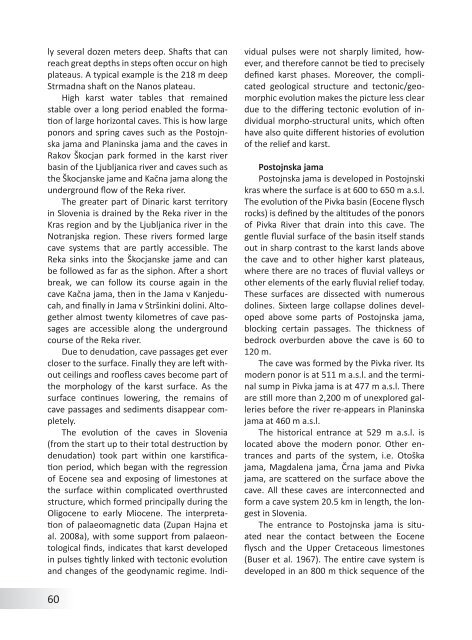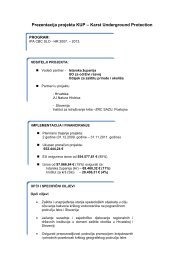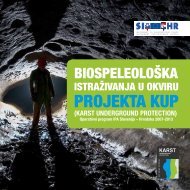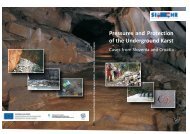Case Studies from the Dinaric Karst of Slovenia
Case Studies from the Dinaric Karst of Slovenia
Case Studies from the Dinaric Karst of Slovenia
You also want an ePaper? Increase the reach of your titles
YUMPU automatically turns print PDFs into web optimized ePapers that Google loves.
ly several dozen meters deep. Shafts that canreach great depths in steps <strong>of</strong>ten occur on highplateaus. A typical example is <strong>the</strong> 218 m deepStrmadna shaft on <strong>the</strong> Nanos plateau.High karst water tables that remainedstable over a long period enabled <strong>the</strong> formation<strong>of</strong> large horizontal caves. This is how largeponors and spring caves such as <strong>the</strong> Postojnskajama and Planinska jama and <strong>the</strong> caves inRakov Škocjan park formed in <strong>the</strong> karst riverbasin <strong>of</strong> <strong>the</strong> Ljubljanica river and caves such as<strong>the</strong> Škocjanske jame and Kačna jama along <strong>the</strong>underground flow <strong>of</strong> <strong>the</strong> Reka river.The greater part <strong>of</strong> <strong>Dinaric</strong> karst territoryin <strong>Slovenia</strong> is drained by <strong>the</strong> Reka river in <strong>the</strong>Kras region and by <strong>the</strong> Ljubljanica river in <strong>the</strong>Notranjska region. These rivers formed largecave systems that are partly accessible. TheReka sinks into <strong>the</strong> Škocjanske jame and canbe followed as far as <strong>the</strong> siphon. After a shortbreak, we can follow its course again in <strong>the</strong>cave Kačna jama, <strong>the</strong>n in <strong>the</strong> Jama v Kanjeducah,and finally in Jama v Stršinkini dolini. Altoge<strong>the</strong>ralmost twenty kilometres <strong>of</strong> cave passagesare accessible along <strong>the</strong> undergroundcourse <strong>of</strong> <strong>the</strong> Reka river.Due to denudation, cave passages get evercloser to <strong>the</strong> surface. Finally <strong>the</strong>y are left withoutceilings and ro<strong>of</strong>less caves become part <strong>of</strong><strong>the</strong> morphology <strong>of</strong> <strong>the</strong> karst surface. As <strong>the</strong>surface continues lowering, <strong>the</strong> remains <strong>of</strong>cave passages and sediments disappear completely.The evolution <strong>of</strong> <strong>the</strong> caves in <strong>Slovenia</strong>(<strong>from</strong> <strong>the</strong> start up to <strong>the</strong>ir total destruction bydenudation) took part within one karstificationperiod, which began with <strong>the</strong> regression<strong>of</strong> Eocene sea and exposing <strong>of</strong> limestones at<strong>the</strong> surface within complicated overthrustedstructure, which formed principally during <strong>the</strong>Oligocene to early Miocene. The interpretation<strong>of</strong> palaeomagnetic data (Zupan Hajna etal. 2008a), with some support <strong>from</strong> palaeontologicalfinds, indicates that karst developedin pulses tightly linked with tectonic evolutionand changes <strong>of</strong> <strong>the</strong> geodynamic regime. Individualpulses were not sharply limited, however,and <strong>the</strong>refore cannot be tied to preciselydefined karst phases. Moreover, <strong>the</strong> complicatedgeological structure and tectonic/geomorphicevolution makes <strong>the</strong> picture less cleardue to <strong>the</strong> differing tectonic evolution <strong>of</strong> individualmorpho-structural units, which <strong>of</strong>tenhave also quite different histories <strong>of</strong> evolution<strong>of</strong> <strong>the</strong> relief and karst.Postojnska jamaPostojnska jama is developed in Postojnskikras where <strong>the</strong> surface is at 600 to 650 m a.s.l.The evolution <strong>of</strong> <strong>the</strong> Pivka basin (Eocene flyschrocks) is defined by <strong>the</strong> altitudes <strong>of</strong> <strong>the</strong> ponors<strong>of</strong> Pivka River that drain into this cave. Thegentle fluvial surface <strong>of</strong> <strong>the</strong> basin itself standsout in sharp contrast to <strong>the</strong> karst lands above<strong>the</strong> cave and to o<strong>the</strong>r higher karst plateaus,where <strong>the</strong>re are no traces <strong>of</strong> fluvial valleys oro<strong>the</strong>r elements <strong>of</strong> <strong>the</strong> early fluvial relief today.These surfaces are dissected with numerousdolines. Sixteen large collapse dolines developedabove some parts <strong>of</strong> Postojnska jama,blocking certain passages. The thickness <strong>of</strong>bedrock overburden above <strong>the</strong> cave is 60 to120 m.The cave was formed by <strong>the</strong> Pivka river. Itsmodern ponor is at 511 m a.s.l. and <strong>the</strong> terminalsump in Pivka jama is at 477 m a.s.l. Thereare still more than 2,200 m <strong>of</strong> unexplored galleriesbefore <strong>the</strong> river re-appears in Planinskajama at 460 m a.s.l.The historical entrance at 529 m a.s.l. islocated above <strong>the</strong> modern ponor. O<strong>the</strong>r entrancesand parts <strong>of</strong> <strong>the</strong> system, i.e. Otoškajama, Magdalena jama, Črna jama and Pivkajama, are scattered on <strong>the</strong> surface above <strong>the</strong>cave. All <strong>the</strong>se caves are interconnected andform a cave system 20.5 km in length, <strong>the</strong> longestin <strong>Slovenia</strong>.The entrance to Postojnska jama is situatednear <strong>the</strong> contact between <strong>the</strong> Eoceneflysch and <strong>the</strong> Upper Cretaceous limestones(Buser et al. 1967). The entire cave system isdeveloped in an 800 m thick sequence <strong>of</strong> <strong>the</strong>60










